Millets and Cereal Meals from the Early Iron Age Underwater Settlement of “Gran Carro” (Bolsena Lake, Central Italy)
Abstract
:1. Introduction
2. Materials and Methods
3. Results
4. Discussion
4.1. Cereal Meals
4.2. Millets: Food Choices, Environmental and Socio-Cultural Dynamics
5. Conclusions
Author Contributions
Funding
Institutional Review Board Statement
Informed Consent Statement
Data Availability Statement
Acknowledgments
Conflicts of Interest
References
- Fioravanti, A.; Camerini, E.; Pennacchioni, G.; Monardo, L. L’abitato Villanoviano del Gran Carro Sommerso nel lago di Bolsena (1959–1977); Tipografia Fratelli De Gennaro: Rome, Italy, 1977; p. 99. [Google Scholar]
- Warden, P.G.; Tamburini, P. Un abitato villanoviano perilacustre: Il “Gran Carro” sul Lago di Bolsena (1959-1985). Am. J. Archaeol. 1997, 101, 800. [Google Scholar] [CrossRef]
- Barbaro, B.; Severi, E. L’abitato sommerso della prima età del Ferro del Gran Carro di Bolsena: Verso una nuova prospettiva. Anal. Archaeol. Int. J. West. Mediterr. Archaeol. 2020, 4, 25–51. [Google Scholar]
- Barbaro, B. L’abitato protostorico del «Gran Carro» di Bolsena: Un complesso insediativo e cultuale di lunga durata sulle rive del lago. rapporto preliminare sulle indagini 2020–2021. Archaeol. Marit. Mediterr. 2022, 18, 97–118. [Google Scholar]
- Cioni, R. L’ambiente subacqueo e le caratteristiche del giacimento. In Il “Gran Carro” sul Lago di Bolsena (1959–1985); Archaeologica 113, Tyrrhenica 5; Tamburini, P., Ed.; Un Abitato Villanoviano Perilacustre: Roma, Italy, 1995; pp. 3–9. [Google Scholar]
- Balista, C.; Leonardi, G. Gli abitati di ambiente umido nel Bronzo Antico dell’Italia settentrionale. In L’antica età del bronzo in Italia; Cocchi Genick, D., Ed.; Atti del Congresso: Viareggio, Italy, 1996; pp. 199–228. [Google Scholar]
- Costantini, L.; Costantini Biasini, L. I Resti Vegetali del Villaggio del “Gran Carro”, Bolsena (VT): Scavo 1974. In Il “Gran Carro” sul lago di Bolsena (1959–1985); Archaeologica 113, Tyrrhenica 5; Tamburini, P., Ed.; Un abitato Villanoviano Perilacustre: Roma, Italy, 1995; pp. 325–333. [Google Scholar]
- Hopf, M. Determinazione dei resti vegetali del villaggio del “Gran Carro” (Lago di Bolsena, Viterbo): Scavo 1980. In Il “Gran Carro” sul Lago di Bolsena (1959–1985); Archaeologica 113, Tyrrhenica 5; Tamburini, P., Ed.; Un Abitato Villanoviano Perilacustre: Roma, Italy, 1995; pp. 336–338. [Google Scholar]
- Antolín, F.; Steiner, B.L.; Akeret, Ö.; Brombacher, C.; Kühn, M.; Vandorpe, P.; Bleicher, N.; Gross, E.; Schaeren, G.; Jacomet, S. Studying the preservation of plant macroremains from waterlogged archaeological deposits for an assessment of layer taphonomy. Rev. Palaeobot. Palynol. 2017, 246, 120–145. [Google Scholar] [CrossRef]
- Celant, A.; Magri, D.; Stasolla, F. Collection of Plant Remains from Archaeological Contexts. In Plant Microtechniques and Protocols; Yeung, E., Stasolla, C., Sumner, M., Huang, B., Eds.; Springer International Publishing: Cham, Switzerland, 2015; pp. 469–485. [Google Scholar]
- Struever, S. Flotation Techniques for the Recovery of Small-Scale Archaeological Remains. Am. Antiq. 1968, 33, 353–362. [Google Scholar] [CrossRef]
- Kroll, H.; Fruèhgeschichte, H.K. S. Jacomet and A. Kreuz, Archäobotanik. Aufgaben, Methoden und Ergebnisse vegetations- und agrargeschichtlicher Forschung (Stuttgart: Ulmer, 1999, 368 pp., hbk., ISBN 3–8252–8158–2 or 3–8001–2707–5). Eur. J. Archaeol. 2001, 4, 289–290. [Google Scholar] [CrossRef]
- Hansen, J.; Pearsall, D.; Hastorf, C.; Popper, V.; Piperno, D. Paleoethnobotany: A Handbook of Procedures. J. Field Archaeol. 1990, 17, 334. [Google Scholar] [CrossRef]
- Jacquat, C. Les Plantes de l’âge du Bronze: Catalogue des Fruits et Graines. Archéologie Neuchâteloise 7; Ed. Du Ruau: Saint-Blaise, Switzerland, 1988; pp. 1–162. [Google Scholar]
- Jacomet, S. Identification of Cereal Remains from Archaeological Sites, 2nd ed.; IPAS, Basel University: Basel, Switzerland, 2006. [Google Scholar]
- Neef, R.; Cappers, R.T.; Bekker, R.M.; Boulos, L.; Dinies, M.; Ertuğ, Z.F.; Keller, N.; Lahitte, M.; Meulenbeld, G.J.; Zhu, Y. Digital Atlas of Economic Plants in Archaeology; Barkhuis Publishing: Eelde, The Netherlands, 2012. [Google Scholar]
- Magri, D.; Di Rita, F. Archaeopalynological Preparation Techniques. In Plant Microtechniques and Protocols; Yeung, E., Stasolla, C., Sumner, M., Huang, B., Eds.; Springer International Publishing: Cham, Switzerland, 2015; pp. 495–506. [Google Scholar]
- Kooyman, B. Phytoliths: Preparation and Archaeological Extraction. In Plant Microtechniques and Protocols; Yeung, E., Stasolla, C., Sumner, M., Huang, B., Eds.; Springer International Publishing: Cham, Switzerland, 2015; pp. 507–524. [Google Scholar]
- Bronk Ramsey, C. Bayesian Analysis of Radiocarbon Dates. Radiocarbon 2009, 51, 337–360. [Google Scholar] [CrossRef] [Green Version]
- Reimer, P.J.; Austin, W.E.N.; Bard, E.; Bayliss, A.; Blackwell, P.G.; Ramsey, C.B.; Butzin, M.; Cheng, H.; Edwards, R.L.; Friedrich, M.; et al. The IntCal20 Northern Hemisphere Radiocarbon Age Calibration Curve (0–55 cal kBP). Radiocarb. 2020, 62, 725–757. [Google Scholar] [CrossRef]
- Heron, C.; Shoda, S.; Barcons, A.B.; Czebreszuk, J.; Eley, Y.; Gorton, M.; Kirleis, W.; Kneisel, J.; Lucquin, A.; Müller, J.; et al. First molecular and isotopic evidence of millet processing in prehistoric pottery vessels. Sci. Rep. 2016, 6, 38767. [Google Scholar] [CrossRef] [Green Version]
- Bordiga, M.; Locatelli, M.; Travaglia, F.; Arlorio, M.; Reyneri, A.; Blandino, M.; Coisson, J.D. Alkylresorcinol content in whole grains and pearled fractions of wheat and barley. J. Cereal Sci. 2016, 70, 38–46. [Google Scholar] [CrossRef]
- Colonese, A.C.; Hendy, J.; Lucquin, A.; Speller, C.F.; Collins, M.; Carrer, F.; Gubler, R.; Kühn, M.; Fischer, R.; Craig, O.E. New criteria for the molecular identification of cereal grains associated with archaeological artefacts. Sci. Rep. 2017, 7, 1–7. [Google Scholar] [CrossRef] [PubMed] [Green Version]
- Hammann, S.; Cramp, L.J. Towards the detection of dietary cereal processing through absorbed lipid biomarkers in archaeological pottery. J. Archaeol. Sci. 2018, 93, 74–81. [Google Scholar] [CrossRef]
- Godelitsas, A.; Price, R.; Pichler, T.; Amend, J.; Gamaletsos, P.; Göttlicher, J. Amorphous As-sulfide precipitates from the shallow-water hydrothermal vents off Milos Island (Greece). Mar. Chem. 2015, 177, 687–696. [Google Scholar] [CrossRef]
- Barbieri, M.; Nigro, A.; Sappa, G. Arsenic contamination in groundwater system of Viterbo area (Central Italy). Senses Sci. 2014, 1, 101–106. [Google Scholar] [CrossRef]
- Lindhorst, K.; Krastel, S.; Wagner, B.; Schuerer, A. Evidence for sub-lacustrine volcanic activity in Lake Bolsena (central Italy) revealed by high resolution seismic data sets. J. Volcanol. Geotherm. Res. 2017, 340, 143–154. [Google Scholar] [CrossRef]
- Barth, A. Infrared spectroscopy of proteins. Biochim. Biophys. Acta Bioenerg. 2007, 1767, 1073–1101. [Google Scholar] [CrossRef] [PubMed] [Green Version]
- van Velzen, E.J.J.; van Duynhoven, J.P.M.; Pudney, P.; Weegels, P.L.; van der Maas, J.H. Factors Associated with Dough Stickiness as Sensed by Attenuated Total Reflectance Infrared Spectroscopy. Cereal Chem. 2003, 80, 378–382. [Google Scholar] [CrossRef]
- Robertson, G.H.; Gregorski, K.S.; Cao, T.K. Changes in Secondary Protein Structures During Mixing Development of High Absorption (90%) Flour and Water Mixtures. Cereal Chem. 2006, 83, 136–142. [Google Scholar] [CrossRef] [Green Version]
- Gallois, N.; Templier, J.; Derenne, S. Pyrolysis-gas chromatography–mass spectrometry of the 20 protein amino acids in the presence of TMAH. J. Anal. Appl. Pyrolysis 2007, 80, 216–230. [Google Scholar] [CrossRef]
- Woychik, J.H.; Boundy, J.A.; Dimler, R.J. Wheat Gluten Proteins, Amino Acid Composition of Proteins in Wheat Gluten. J. Agric. Food Chem. 1961, 9, 307–310. [Google Scholar] [CrossRef]
- Wieser, H. Chemistry of gluten proteins. Food Microbiol. 2007, 24, 115–119. [Google Scholar] [CrossRef]
- Rombouts, I.; Lamberts, L.; Celus, I.; Lagrain, B.; Brijs, K.; Delcour, J.A. Wheat gluten amino acid composition analysis by high-performance anion-exchange chromatography with integrated pulsed amperometric detection. J. Chromatogr. A 2009, 1216, 5557–5562. [Google Scholar] [CrossRef] [PubMed]
- Wang, S.; Guo, X.; Liang, T.; Zhou, Y.; Luo, Z. Mechanism research on cellulose pyrolysis by Py-GC/MS and subsequent density functional theory studies. Bioresour. Technol. 2012, 104, 722–728. [Google Scholar] [CrossRef] [PubMed]
- Galletti, G.C.; D’antuono, L.F.; Bocchini, P.; Rosolen, I.I. Pyrolysis/gas chromatography/mass spectrometry of spelt (Triticum spelta L.) pericarp. Rapid Commun Mass Spectrom. 1998, 12, 1801–1807. [Google Scholar] [CrossRef]
- del Río, J.C.; Prinsen, P.; Gutiérrez, A. Chemical composition of lipids in brewer’s spent grain: A promising source of valuable phytochemicals. J. Cereal Sci. 2013, 58, 248–254. [Google Scholar] [CrossRef] [Green Version]
- Valamoti, S.M.; Marinova, E.; Heiss, A.G.; Hristova, I.; Petridou, C.; Popova, T.; Michou, S.; Papadopoulou, L.; Chrysostomou, P.; Darcque, P.; et al. Prehistoric cereal foods of southeastern Europe: An archaeobotanical exploration. J. Archaeol. Sci. 2019, 104, 97–113. [Google Scholar] [CrossRef]
- Heiss, A.G.; Antolín, F.; Bleicher, N.; Harb, C.; Jacomet, S.; Kühn, M.; Marinova, E.; Stika, H.-P.; Valamoti, S.M. State of the (t)art. Analytical approaches in the investigation of components and production traits of archaeological bread-like objects, applied to two finds from the Neolithic lakeshore settlement Parkhaus Opéra (Zürich, Switzerland). PLoS ONE 2017, 12, e0182401. [Google Scholar] [CrossRef] [Green Version]
- Sigaut, F. A Method for Identifying Grain Storage Techniques and Its Application for European Agricultural History. Tools Tillage 1988, 6, 3–32. [Google Scholar]
- Guglielmino, R.; Primavera, M. Le offerte vegetali a Roca tra pratiche rituali e riferimenti simbolici. In Studi di Preistoria e Protostoria; Istituto Italiano di Preistoria e Protostoria: Firenze, Italy, 2021. [Google Scholar]
- Carretero, L.G.; Wollstonecroft, M.; Fuller, D.Q. A methodological approach to the study of archaeological cereal meals: A case study at Çatalhöyük East (Turkey). Veg. Hist. Archaeobotany 2017, 26, 415–432. [Google Scholar] [CrossRef] [Green Version]
- Primavera, M.; Heiss, A.G.; Valamoti, M.S.; Quarta, G.; Masieri, M.; Fiorentino, G. Inside sacrificial cakes: Plant components and production processes of food offerings at the Demeter and Persephone sanctuary of Monte Papalucio (Oria, southern Italy). Archaeol. Anthr. Sci. 2018, 11, 1273–1287. [Google Scholar] [CrossRef]
- Arranz-Otaegui, A.; Carretero, L.G.; Ramsey, M.N.; Fuller, D.Q.; Richter, T. Archaeobotanical evidence reveals the origins of bread 14,400 years ago in northeastern Jordan. Proc. Natl. Acad. Sci. USA 2018, 115, 7925–7930. [Google Scholar] [CrossRef] [PubMed] [Green Version]
- Hillman, G.; Wales, S.; McLaren, F.; Evans, J.; Butler, A. Identifying problematic remains of ancient plant foods: A comparison of the role of chemical, histological and morphological criteria. World Archaeol. 1993, 25, 94–121. [Google Scholar] [CrossRef]
- Fors, Y.; Sandström, M. Sulfur and iron in shipwrecks cause conservation concerns. Chem. Soc. Rev. 2006, 35, 399–415. [Google Scholar] [CrossRef] [PubMed]
- Gelbrich, J.; Mai, C.; Militz, H. Chemical changes in wood degraded by bacteria. Int. Biodeterior. Biodegrad. 2008, 61, 24–32. [Google Scholar] [CrossRef]
- Colombini, M.P.; Lucejko, J.J.; Modugno, F.; Orlandi, M.; Tolppa, E.-L.; Zoia, L. A multi-analytical study of degradation of lignin in archaeological waterlogged wood. Talanta 2009, 80, 61–70. [Google Scholar] [CrossRef]
- Hansson, A.M.; Isaksson, S. Analyses of charred organic remains. Lab. Arkeol. 1994, 7, 21–29. [Google Scholar]
- Evershed, R.P. Chemical composition of a bog body adipocere. Archaeometry 1992, 34, 253–265. [Google Scholar] [CrossRef]
- Nielsen, N.H.; Henriksen, P.S.; Mortensen, M.F.; Enevold, R.; Mortensen, M.N.; Scavenius, C.; Enghild, J.J. The last meal of Tollund Man: New analyses of his gut content. Antiquity 2021, 95, 1195–1212. [Google Scholar] [CrossRef]
- Shen, S.; Li, X.-F.; Cullen, W.R.; Weinfeld, M.; Le, X.C. Arsenic Binding to Proteins. Chem. Rev. 2013, 113, 7769–7792. [Google Scholar] [CrossRef]
- Turksoy, S.; Erturk, M.Y.; Kokini, J. Behavior of semolina, hard, soft wheat flour dough at different aging times and temperatures through LAOS properties and molecular interactions of proteins. J. Food Eng. 2021, 301, 110549. [Google Scholar] [CrossRef]
- Garcia-Valle, D.E.; Bello-Pérez, L.A.; Agama-Acevedo, E.; Alvarez-Ramirez, J. Effects of mixing, sheeting, and cooking on the starch, protein, and water structures of durum wheat semolina and chickpea flour pasta. Food Chem. 2021, 360, 129993. [Google Scholar] [CrossRef] [PubMed]
- Ross, A.B.; Shepherd, M.J.; Schüpphaus, M.; Sinclair, V.; Alfaro, B.; Kamal-Eldin, A.A.; Åman, P. Alkylresorcinols in Cereals and Cereal Products. J. Agric. Food Chem. 2003, 51, 4111–4118. [Google Scholar] [CrossRef] [PubMed]
- Landberg, R.; Kamal-Eldin, A.; Salmenkallio-Marttila, M.; Rouau, X.; Åman, P. Localization of alkylresorcinols in wheat, rye and barley kernels. J. Cereal Sci. 2008, 48, 401–406. [Google Scholar] [CrossRef]
- Costantini, L. Italia centro-meridionale. In Storia dell’agricoltura Italiana, I L’età Antica, 1 Prestoria, Accademia dei Georgogili; Forni, G., Marcone, A., Eds.; Edizioni Polistampa: Firenze, Italy, 2002; pp. 221–234. [Google Scholar]
- Fiorentino, G.; Castiglioni, E.; Rottoli, M.; Nisbet, R.R. Le colture agricole in Italia nel corso dell’età del Bronzo: Sintesi dei dati e linee di tendenza. In L’età Del Bronzo Recente Ital; Atti del Congresso Nazionale di Lido di Camaiore: Viareggio, Italy, 2004; pp. 219–226. [Google Scholar]
- Tafuri, M.A.; Rottoli, M.; Cupitò, M.; Pulcini, M.L.; Tasca, G.; Carrara, N.; Bonfanti, F.; Salzani, L.; Canci, A. Estimating C4plant consumption in Bronze Age Northeastern Italy through stable carbon and nitrogen isotopes in bone collagen. Int. J. Osteoarchaeol. 2018, 28, 131–142. [Google Scholar] [CrossRef]
- Rottoli, M.; Castiglioni, E. Prehistory of plant growing and collecting in northern Italy, based on seed remains from the early Neolithic to the Chalcolithic (c. 5600–2100 cal b.c.). Veg. Hist. Archaeobotany 2009, 18, 91–103. [Google Scholar] [CrossRef]
- Tecchiati, U.; Castiglioni, E.; Rottoli, M. Economia di sussistenza nell’età del Rame dell’Italia settentrionale. Il contributo di archeozoologia e archeobotanica. In L’Età del Rame. La Pianura Padana e le Alpi al Tempo di Otzi; De Marinis, R.C., Ed.; Compagnia della Stampa Massetti Rodella Editori: Brescia, Italy, 2013; pp. 87–100. [Google Scholar]
- Motuzaite-Matuzeviciute, G.; Staff, R.A.; Hunt, H.V.; Liu, X.; Jones, M.K. The Early Chronology of Broomcorn Millet (Panicum mmiliaceum) in Europe. Antiquity 2013, 87, 1073–1085. [Google Scholar] [CrossRef] [Green Version]
- Herrscher, E.; André, G.; Bodet, C.; Chataigner, C.; Decaix, A.; Goude, G.; Hamon, C.; Mort, F.L.; Lyonnet, B.; Martin, L.; et al. The origins of millet cultivation in the Caucasus: Archaeological and archaeometric approaches. Préhistoires Méditerranéennes 2018, 6, 28. [Google Scholar]
- Filipović, D.; Meadows, J.; Del Corso, M.; Kirleis, W.; Alsleben, A.; Akeret, Ö.; Bittmann, F.; Bosi, G.; Ciută, B.; Dreslerová, D.; et al. New AMS 14C dates track the arrival and spread of broomcorn millet cultivation and agricultural change in prehistoric Europe. Sci. Rep. 2020, 10, 1–18. [Google Scholar] [CrossRef]
- Martin, L.; Messager, E.; Bedianashvili, G.; Rusishvili, N.; Lebedeva, E.; Longford, C.; Hovsepyan, R.; Bitadze, L.; Chkadua, M.; Vanishvili, N.; et al. The place of millet in food globalization during Late Prehistory as evidenced by new bioarchaeological data from the Caucasus. Sci. Rep. 2021, 11, 1–11. [Google Scholar] [CrossRef]
- Außerlechner, M.V. Plant use and rites at burnt offering sites in the Eastern Alps during the Bronze and Iron Ages. Veg. Hist. Archaeobotany 2021, 30, 155–170. [Google Scholar] [CrossRef]
- Nisbet, R. Offerte Votive e Analisi Botaniche. In: Il sito protostorico di Custoza (Sommacampagn-Verona). Quad. Di Padusa 1999, 1996/1997, 15–16. [Google Scholar]
- Mercuri, A.M.; Accorsi, C.A.; Mazzanti, M.B.; Bosi, G.; Cardarelli, A.; Labate, D.; Marchesini, M.; Grandi, G.T. Economy and environment of Bronze Age settlements—Terramaras— on the Po Plain (Northern Italy): First results from the archaeobotanical research at the Terramara di Montale. Veg. Hist. Archaeobotany 2006, 16, 43–60. [Google Scholar] [CrossRef]
- Cremaschi, M.; Mercuri, A.M.; Torri, P.; Florenzano, A.; Pizzi, C.; Marchesini, M.; Zerboni, A. Climate change versus land management in the Po Plain (Northern Italy) during the Bronze Age: New insights from the VP/VG sequence of the Terramara Santa Rosa di Poviglio. Quat. Sci. Rev. 2016, 136, 153–172. [Google Scholar] [CrossRef]
- Perego, R. Contribution to the Development of the Bronze Age Plant Economy in the Surrounding of the Alps: An Archaeobotanical Case Study of Two Early and Middle Bronze Age Sites in Northern Italy (Lake Garda Region). Ph.D. Thesis, University of Basel, Basel, Switzerland, 2017. [Google Scholar]
- Tafuri, M.A.; Craig, O.E.; Canci, A. Stable isotope evidence for the consumption of millet and other plants in Bronze Age Italy. Am. J. Phys. Anthr. 2009, 139, 146–153. [Google Scholar] [CrossRef]
- Cavazzuti, C.; Skeates, R.; Millard, A.R.; Nowell, G.; Peterkin, J.; Bernabò Brea, M.; Cardarelli, A.; Salzani, L. Flows of people in villages and large centres in Bronze Age Italy through strontium and oxygen isotopes. PLoS ONE 2019, 14, e0209693. [Google Scholar] [CrossRef] [PubMed]
- Varalli, A.; Moggi-Cecchi, J.; Moroni, A.; Goude, G. Dietary Variability During Bronze Age in Central Italy: First Results. Int. J. Osteoarchaeol. 2016, 26, 431–446. [Google Scholar] [CrossRef]
- Castelletti, L. Rapporto preliminare sui resti vegetali macroscopici della serie Neolitico-Bronzo di Pienza (Siena). Riv. Archeol. Dell’antica Prov. E Diocesi Como 1976, 156–157, 243–251. [Google Scholar]
- Tongiorgi, E. Grano, Miglio e Fave in Un focolare rituale dell’Età del Bronzo a Grotta Misa. Nuovo G. Bot. Ital. 1947, 54, 804. [Google Scholar]
- Rumolo, A.; Forstenpointner, G.; Rumolo, P.; Jung, R. Palaeodiet reconstruction inferred by stable isotopes analysis of faunal and human remains at Bronze Age Punta di Zambrone (Calabria, Italy). Int. J. Osteoarchaeol. 2019, 30, 90–98. [Google Scholar] [CrossRef]
- Livadie, C.A.; Pearce, M.; Donne, M.D.; Pizzano, N. The effects of the Avellino Pumice eruption on the population of the Early Bronze age Campanian plain (Southern Italy). Quat. Int. 2019, 499, 205–220. [Google Scholar] [CrossRef]
- Castiglioni, E.; Rottoli, M. Capua (Caserta). Località Strepparo e Cento Moggie. Scavi nell’area del CIRA. Resti botanici da un pozzo dell’età del Bronzo. Boll. Archeol. 1996, 37–38, 62–67. [Google Scholar]
- Delle Donne, M. Analisi archeobotaniche preliminari. In Dopo lo Tsunami; Campanelli, A., Ed.; Salerno Antica: Napoli, Italy, 2011; pp. 134–137. [Google Scholar]
- Nisbet, R. Uso del Legno ed Economia Agricola al Castellaro di Uscio. In Archeologia Dell’appennino Ligure. Gli Scavi del Castellaro di Uscio: Un Insediamento di Crinale dal Neolitico alla Conquista Romana; Maggi, R., Ed.; Coll Monogr Preistoriche Archeol: Bordighera, Italy, 1990; pp. 197–208. [Google Scholar]
- Nisbet, R. Late Iron Age Balanophagy and Leaf-Fodder in the Lower Valpolicella (Verona, Italy). Preist. Alp. 2021, 51, 107–120. [Google Scholar]
- Rottoli, M.; Fanetti, D.; Bosi, G.; Castiglioni, E. The agriculture in Northern Italy during Iron Age: A review. In Proceedings of the 17th Conference of the International Workgroup for Palaeoethnobotany, Paris, France, 4–9 July 2016. [Google Scholar]
- Sala, I.; Rottoli, M. Le Offerte Vegetali nella Tomba 12/2005 della Necropoli Lippi di Verucchio (ca. 680-640 AC). ARIMNESTOS Ric. Di Prot. Mediterr. 2018, 1, 47–58. [Google Scholar]
- Arobba, D.; Caramiello, R.; Del Lucchese, A. Archaeobotanical investigations in Liguria: Preliminary data on the early Iron Age at Monte Trabocchetto (Pietra Ligure, Italy). Veg. Hist. Archaeobotany 2003, 12, 253–262. [Google Scholar] [CrossRef]
- Bellini, C.; Mariotti-Lippi, M.; Secci, M.M.; Aranguren, B.; Perazzi, P. Plant gathering and cultivation in prehistoric Tuscany (Italy). Veg. Hist. Archaeobotany 2008, 17, 103–112. [Google Scholar] [CrossRef]
- Helbaek, H. Vegetables in the funeral meals of pre-urban Rome. In Early Rome; Gjerstad, E., Ed.; Gleerup: Lund, Sweden, 1956; pp. 287–294. [Google Scholar]
- Costantini, L.; Giorgi, J. Charred plant remains of the Archaic period from the Forum and Palatine. J. Rom. Archaeol. 2001, 14, 239–248. [Google Scholar] [CrossRef]
- Jarman, H.N. The plant remains. In A Faliscan Town in South Etruria: Excavations at Narce 1966–1971; Potter, T.W.P., Ed.; British School at Rome: London, UK, 1976; pp. 308–310. [Google Scholar]
- Marinval, P. Archaeobotanical data on millets (Panicum miliaceum and Setaria italica) in France. Rev. Palaeobot. Palynol. 1992, 73, 259–270. [Google Scholar] [CrossRef]
- Schmidl, A.; Jacomet, S.; Oeggl, K. Distribution patterns of cultivated plants in the Eastern Alps (Central Europe) during Iron Age. J. Archaeol. Sci. 2007, 34, 243–254. [Google Scholar] [CrossRef]
- Hunt, H.V.; Linden, M.V.; Liu, X.; Motuzaite-Matuzeviciute, G.; Colledge, S.; Jones, M.K. Millets across Eurasia: Chronology and context of early records of the genera Panicum and Setaria from archaeological sites in the Old World. Veg. Hist. Archaeobotany 2008, 17, 5–18. [Google Scholar] [CrossRef] [PubMed] [Green Version]
- Dreslerová, D.; Kočár, P. Trends in cereal cultivation in the Czech Republic from the Neolithic to the Migration period (5500 b.c.–a.d. 580). Veg. Hist. Archaeobotany 2013, 22, 257–268. [Google Scholar] [CrossRef]
- Reed, K.; Drnić, I. Iron Age Diet at Sisak, Croatia: Archaeobotanical Evidence of Foxtail Millet (Setaria Italica [L.] P. Beauv.). Oxf. J. Archaeol. 2016, 35, 359–368. [Google Scholar] [CrossRef]
- Alonso, N.; Bouby, L. Plant Resources from the Bronze Age and the first Iron Age in the northwestern arc of the Mediterranean Basin. Comptes Rendus. Palevol. 2017, 16, 363–377. [Google Scholar] [CrossRef] [Green Version]
- Goude, G.; Rey, L.; Toulemonde, F.; Cervel, M.; Rottier, S. Dietary changes and millet consumption in northern France at the end of Prehistory: Evidence from archaeobotanical and stable isotope data. Environ. Archaeol. 2016, 22, 268–282. [Google Scholar] [CrossRef]
- Rottoli, M.; Castiglioni, E. Plant offerings from Roman cremations in northern Italy: A review. Veg. Hist. Archaeobotany 2011, 20, 495–506. [Google Scholar] [CrossRef]
- Bosi, G.; Castiglioni, E.; Rinaldi, R.; Mazzanti, M.; Marchesini, M.; Rottoli, M. Archaeobotanical evidence of food plants in Northern Italy during the Roman period. Veg. Hist. Archaeobotany 2020, 29, 681–697. [Google Scholar] [CrossRef]
- Murphy, C.; Thompson, G.; Fuller, D.Q. Roman food refuse: Urban archaeobotany in Pompeii, Regio VI, Insula 1. Veg. Hist. Archaeobotany 2013, 22, 409–419. [Google Scholar] [CrossRef]
- Buonincontri, M.P.; Pecci, A.; Di Pasquale, G.; Ricci, P.; Lubritto, C. Multiproxy approach to the study of Medieval food habits in Tuscany (central Italy). Archaeol. Anthr. Sci. 2017, 9, 653–671. [Google Scholar] [CrossRef]
- Primavera, M.; Colella, M.C.; Minervini, I.; Calò, P.; Fiorentino, G. Dai contesti all’approccio: Strategie di campionamento e nuove metodologie di analisi archeobotaniche a Miranduolo (Chiusdino, SI). In Proceedings of the VIII Congresso Nazionale di Archeologia Medievale, Matera, Italy, 12–15 September 2018; pp. 51–55. [Google Scholar]
- Valamoti, S.M. Millet, the late comer: On the tracks of Panicum miliaceum in prehistoric Greece. Archaeol. Anthr. Sci. 2016, 8, 51–63. [Google Scholar] [CrossRef]
- Dvoracek, V.; Janovska, D.; Papouskova, L.; Bicanova, E. Post-Harvest content of free titrate acids in the grains of proso millet varieties (Panicum miliaceum L.) and changes during grain processing and storage. Czech J. Genet. Plant Breed. 2010, 46, 90–95. [Google Scholar] [CrossRef] [Green Version]
- Bettencourt, A.M.S. Plant and animal husbandry in the second millennium BC in northern Portugal. J. Iber. Archaeol. 2003, 5, 199–208. [Google Scholar]
- Tereso, J.P.; Bettencourt, A.M.; Ramil-Rego, P.; Teira-Brión, A.; López-Dóriga, I.; Lima, A.; Almeida, R. Agriculture in NW Iberia during the Bronze Age: A review of archaeobotanical data. J. Archaeol. Sci. Rep. 2016, 10, 44–58. [Google Scholar] [CrossRef] [Green Version]
- Peña-Chocarro, L.; Pérez-Jordà, G. Los estudios carpológicos en la Península Ibérica: Un estado de la cuestión. Pyrenae 2018, 49/1, 7–45. [Google Scholar] [CrossRef]
- Pérez-Jordà, G.; Peña-Chocarro, L.; Picornell-Gelabert, L.; Marco, Y.C. Agriculture between the third and first millennium BC in the Balearic Islands: The archaeobotanical data. Veg. Hist. Archaeobotany 2017, 27, 253–265. [Google Scholar] [CrossRef]
- Peña-Chocarro, L.; Jordà, G.P.-; Alonso, N.; Antolín, F.; Teira-Brión, A.; Tereso, J.P.; Moya, E.M.M.; Reyes, D.L. Roman and medieval crops in the Iberian Peninsula: A first overview of seeds and fruits from archaeological sites. Quat. Int. 2019, 499, 49–66. [Google Scholar] [CrossRef]
- Di Rita, F.; Lirer, F.; Bonomo, S.; Cascella, A.; Ferraro, L.; Florindo, F.; Insinga, D.D.; Lurcock, P.C.; Margaritelli, G.; Petrosino, P.; et al. Late Holocene forest dynamics in the Gulf of Gaeta (central Mediterranean) in relation to NAO variability and human impact. Quat. Sci. Rev. 2018, 179, 137–152. [Google Scholar] [CrossRef]
- Michelangeli, F.; Di Rita, F.; Celant, A.; Tisnérat-Laborde, N.; Lirer, F.; Magri, D. Three Millennia of Vegetation, Land-Use, and Climate Change in SE Sicily. Forests 2022, 13, 102. [Google Scholar] [CrossRef]
- Magny, M.; de Beaulieu, J.-L.; Drescher-Schneider, R.; Vannière, B.; Walter-Simonnet, A.-V.; Miras, Y.; Millet, L.; Bossuet, G.; Peyron, O.; Brugiapaglia, E.; et al. Holocene climate changes in the central Mediterranean as recorded by lake-level fluctuations at Lake Accesa (Tuscany, Italy). Quat. Sci. Rev. 2007, 26, 1736–1758. [Google Scholar] [CrossRef]
- Murphy, C. Finding millet in the Roman world. Archaeol. Anthr. Sci. 2015, 8, 65–78. [Google Scholar] [CrossRef] [Green Version]
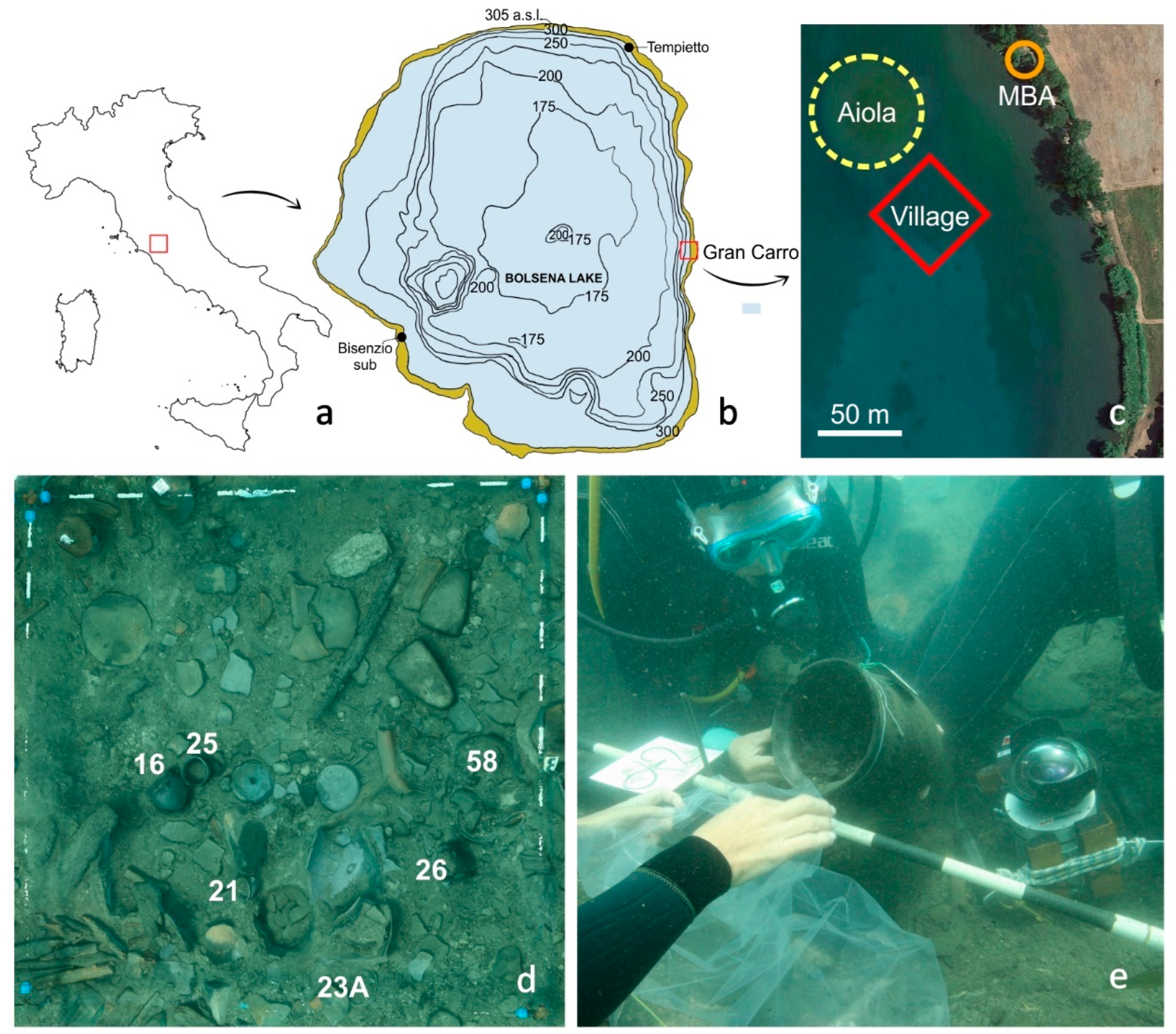

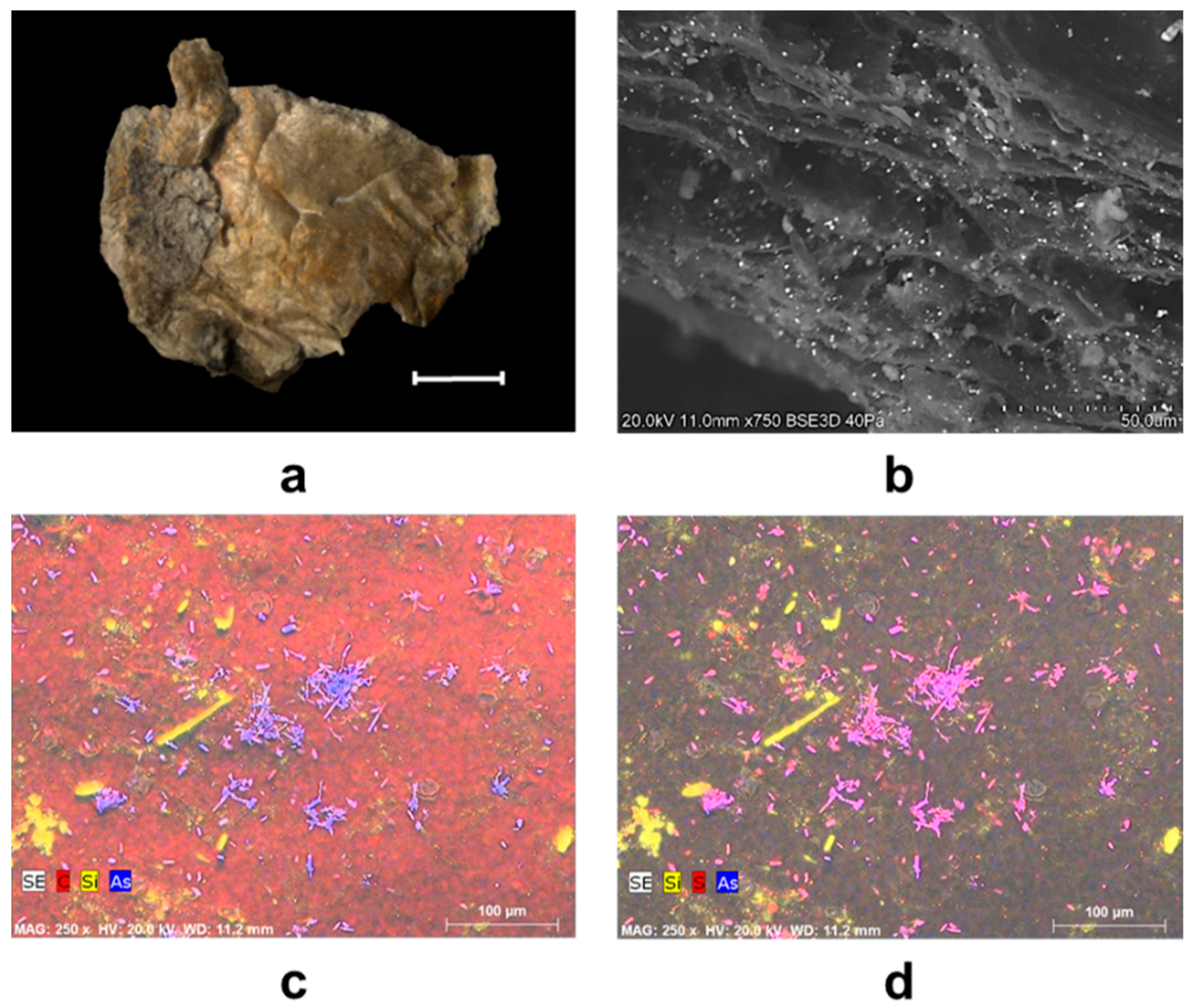

| Number | Photograph | Form |
|---|---|---|
| Vessel 16 | 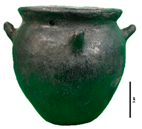 | globular “olletta” with four protrusions |
| Vessel 21 |  | small, rounded bowl with one perforated handle, on raised leg |
| Vessel 23A | 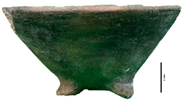 | conical bowl on four legs |
| Vessel 23B |  | biconical jar with encrusted geometric decorations |
| Vessel 25 | 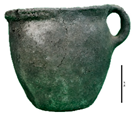 | beaker with one handle |
| Vessel 26 |  | small pot with two handles and impressed decoration |
| Vessel 38 | 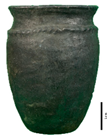 | ovoid vessel with corded decoration |
| Vessel 42 |  | beaker with one ribbon handle |
| Vessel 58 |  | conical bowl on four legs |
| Wet Volume of Processed Sediment (dm3) | Type of Remain | Triticum dicoccum | Hordeum vulgare | Panicum miliaceum | Setaria italica | |
|---|---|---|---|---|---|---|
| Vessel 16 | 0.3 | caryopsis | 4 | 1 | 7 | 1 |
| spikelet | 4 | - | - | - | ||
| Vessel 21 | 0.13 | caryopsis | 3 | - | 1 | 4 |
| spikelet | 2 | - | - | - | ||
| Vessel 23A | 0.45 | caryopsis | - | - | 4 | 4 |
| Vessel 23B | 0.5 | caryopsis | 9 | - | - | 1 |
| spikelet | 4 | - | - | - | ||
| Vessel 25 | 0.5 | caryopsis | 1 | - | 1 | 2 |
| spikelet | 1 | - | - | - | ||
| Vessel 26 | 0.045 | organic residue | ||||
| Vessel 38 | 0.45 | caryopsis | - | 6 | agglomeration | 4 |
| fork | - | 2 | - | - | ||
| Vessel 42 | 0.4 | caryopsis | 9 | |||
| spikelet | 4 | - | - | |||
| fork | 1 | - | - | - | ||
| Vessel 58 | 0.6 | caryopsis | 2 | 4 | 1 | 8 |
| fork | - | 1 | - | - | ||
| Total number of remains | 35 | 14 | 14 | 33 | ||
| Compounds | RT (min) | Compounds | RT (min) |
|---|---|---|---|
| PROTEIN MARKERS | CELLULOSE MARKERS | ||
| 1H-Pyrrole, 1-methyl- | 2.6508 | Cyclopentanone | 2.9817 |
| Pyridine | 2.7017 | Furfural | 3.2517 |
| Pyrrole | 2.7408 | Benzene, 1,3-dimethyl- | 3.5175 |
| Toluene | 2.8358 | 2-Cyclopenten-1-one, 2-methyl- | 3.7592 |
| 1H-Pyrrole, 3-methyl- | 3.3367 | 2(5H)-Furanone | 3.8092 |
| Acetamide, N,N-dimethyl- | 3.5083 | Cyclohexanone | 3.8792 |
| Phenol | 4.2442 | 2-Furancarboxaldehyde, 5-methyl- | 4.1525 |
| Benzene, 1-methoxy-4-methyl- | 4.6083 | 1,2-Cyclopentanedione, 3-methyl- | 4.6608 |
| Phenol, 2-methyl- | 4.8325 | Maltol | 5.3933 |
| Phenol, 3-methyl- | 4.9817 | Levoglucosan | 8.7942 |
| 2,5-Pyrrolidinedione, 1-methyl- | 5.1400 | LIPIDIC COMPOUNDS | |
| Phenol, 2,5-dimethyl- | 5.6325 | Hexadecanoic acid, methyl ester | 12.1583 |
| Phenol, 4-ethyl- | 5.7708 | Octadecanoic acid, methyl ester | 13.8642 |
| Benzofuran, 2,3-dihydro- | 6.2350 | Eicosanoic acid, methyl ester | 15.7850 |
| 1-Methylindole | 6.9142 | Docosanoic acid, methyl ester | 17.8650 |
| Indole | 7.0800 | Tetracosanoic acid, methyl ester | 19.4967 |
| L-Proline, 5-oxo-, methyl ester | 7.7017 | Hexacosanoic acid, methyl ester | 20.7467 |
| 1H-Isoindole-1,3(2H)-dione, 2-methyl- | 8.2900 | Octacosanoic acid, methyl ester | 22.2333 |
| L-Proline, 1-methyl-5-oxo-, methyl ester | 9.5817 | STEROLS | |
| Pyrrolo[1,2-a]pyrazine-1,4-dione, hexahydro- | 11.1192 | Sitosterol | 24.9225 |
| 9H-Pyrido[3,4-b]indole, 1-methyl- | 12.9533 | ||
| 9H-Pyrido[3,4-b]indole | 13.0367 |
Publisher’s Note: MDPI stays neutral with regard to jurisdictional claims in published maps and institutional affiliations. |
© 2022 by the authors. Licensee MDPI, Basel, Switzerland. This article is an open access article distributed under the terms and conditions of the Creative Commons Attribution (CC BY) license (https://creativecommons.org/licenses/by/4.0/).
Share and Cite
Fundurulic, A.; Valenti, I.; Celant, A.; Barbaro, B.; Costa, M.; Manhita, A.; Severi, E.; Barrocas Dias, C.; Magri, D. Millets and Cereal Meals from the Early Iron Age Underwater Settlement of “Gran Carro” (Bolsena Lake, Central Italy). Sustainability 2022, 14, 3941. https://doi.org/10.3390/su14073941
Fundurulic A, Valenti I, Celant A, Barbaro B, Costa M, Manhita A, Severi E, Barrocas Dias C, Magri D. Millets and Cereal Meals from the Early Iron Age Underwater Settlement of “Gran Carro” (Bolsena Lake, Central Italy). Sustainability. 2022; 14(7):3941. https://doi.org/10.3390/su14073941
Chicago/Turabian StyleFundurulic, Ana, Ilenia Valenti, Alessandra Celant, Barbara Barbaro, Mafalda Costa, Ana Manhita, Egidio Severi, Cristina Barrocas Dias, and Donatella Magri. 2022. "Millets and Cereal Meals from the Early Iron Age Underwater Settlement of “Gran Carro” (Bolsena Lake, Central Italy)" Sustainability 14, no. 7: 3941. https://doi.org/10.3390/su14073941
APA StyleFundurulic, A., Valenti, I., Celant, A., Barbaro, B., Costa, M., Manhita, A., Severi, E., Barrocas Dias, C., & Magri, D. (2022). Millets and Cereal Meals from the Early Iron Age Underwater Settlement of “Gran Carro” (Bolsena Lake, Central Italy). Sustainability, 14(7), 3941. https://doi.org/10.3390/su14073941








